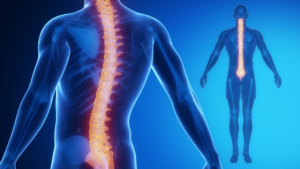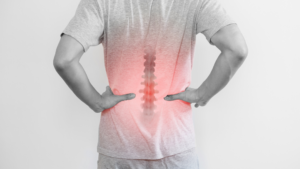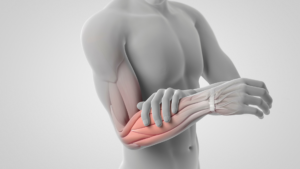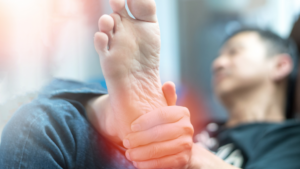Chronic fatigue syndrome(CFS), also known as myalgic encephalomyelitis (ME) or systemic exertion intolerance disease (SEID), is a debilitating disorder often characterized by extreme fatigue that is long-lasting. This disorder is complicated in that it can neither go away with rest nor even be explained by an underlying medical condition. In addition, the causes of chronic fatigue syndrome are unknown, although theories are speculating about the possible causes of this disorder.
Having said that, the following is a breakdown to help you understand CFS and the possible treatments.

Pain Symptoms of CFS
Symptoms of Chronic Fatigue Syndrome
Although fatigue is a common symptom of chronic fatigue syndrome, it is worth noting that the symptoms may vary from one person to another. What’s more, the severity of the symptoms may fluctuate from day to day.
Other symptoms associated with CFS include:
- problems with memory or concentration
- Headaches
- Unexplained muscle or joint pain
- Unrefreshing sleep
- Frequent sore throats
- Tender and swollen lymph nodes in your neck and armpits
- Chronic insomnia
How is CFS Treated?
Despite comprehensive research, the complexity of this disorder has made it difficult to find a specific cure. In addition, people diagnosed with this condition exhibit different symptoms; therefore, different medications and treatment techniques are used to manage the symptoms. As such, before taking further steps, it is imperative to speak to your physician, who can advise you on the proper treatment to undertake.
That said, the following are some treatment options available helpful in managing the disorder and relieving the symptoms:
Medications
Some symptoms of CFS can be managed through prescription and over-the-counter drugs. For example:
Pain: can be addressed by taking medications such as ibuprofen and naproxen sodium. If over-the-counter medication doesn’t relieve the pain, your doctor may recommend medications used to treat Fibromyalgia.
Depression: Many people suffering from this disorder exhibit depression as one of the symptoms. This can be dealt with by taking antidepressants that can help relieve pain and, at the same time, reduce stress.
Therapy
Therapy is another treatment option for people with chronic fatigue syndrome. Putting it briefly, the benefits of therapy are immense as far as CFS is concerned. Therapy typically helps address:
Sleep problems: Your doctor may recommend a suitable sleep routine to the effect that it counters sleep disorders and, at the same time it helps deal with chronic pain.
Worsening conditions: Exercising as a regimen helps counter the debilitating symptoms of CFS and even the worsening conditions. As such, your doctor may advise you on the various exercises to undertake and how you should go about it.
Post-External Malaise
People with CFS often experience a worsening of their symptoms after undertaking either physical or mental activities. This is what is known as Post-External Malaise, and it can last for an extended period.
As such, CFS patients are advised not to do things overtly. Instead, they are required to maintain a balance between activity and rest. This can be achieved by keeping a daily diary of the activities and symptoms to help you stay on track.
Final Thoughts
Chronic fatigue syndrome can lead to immense pain. Often confused with Fibromyalgia, the disorder can be challenging to point out from the onset. Therefore, patients need to be diagnosed appropriately and ultimately subjected to the proper treatment to manage the symptoms.
Having said that, if you or your loved one suspect that you have chronic fatigue syndrome, it is essential to consult a doctor immediately. In essence, a qualified physician can recommend proper care and treatment.
Contact Progressive Pain Management today to learn more about Chronic Fatigue Syndrome and how our team can help with symptoms.
Cognitive Behavioral Therapy is a treatment approach that combines techniques to help people identify and correct faulty patterns of thoughts, feelings, and behaviors. The goal is to increase function and reduce pain.
A Brief History
Cognitive Behavioral Therapy was developed in the mid-1970s by Dr. John Sarno, a clinical professor of rehabilitation medicine at New York University School of Medicine. It is based on his belief that most lower back pain results from unconscious emotional factors, particularly feelings of stress and anxiety in the muscles of the lower back and abdomen.
According to Dr. Sarno, when people unconsciously repress feelings or emotions they often experience physical symptoms in the body as a consequence of the unconscious mind acting to protect them in some way.

Treating Low Back Pain with CBT
He believes that most people who develop lower back pain have repressed anger toward someone else or themselves, which he calls ‘core beliefs’. Core beliefs are often formed in childhood and are the result of unresolved emotional conflicts. The pain creates fear, further suppressing emotions, resulting in a vicious cycle.
Dr. Sarno’s approach focuses on getting patients to become aware of these unconscious emotions and how they affect their physical well-being through persistent pain. He teaches people to reinterpret the pain in a positive way, as a sign that they can now initiate the healing process.
How Cognitive Behavioral Therapy Works
Cognitive Behavioral Therapy takes place in six to eight weekly sessions, each lasting an hour. The first session is about education and explaining how pain might develop. The remaining sessions are spent discussing memories in the patient’s life that may be linked to the pain, identifying repressed emotions, and working out strategies to deal with them.
The interactive sessions aim to help patients become aware of patterns that can trigger their pain, such as poor time management or expectations set too high by family members. They also explore how a patient’s thoughts and emotions affect the sensations in the lower back. A key part of Cognitive Behavioral Therapy is becoming aware of ‘early warning signs’ so they can be acted upon before pain becomes a problem.
Cognitive Behavioral Therapy for Lower Back Pain focuses on the mind-body connection and how emotions affect physical health, partially through stress hormones such as cortisol, which have been linked to chronic pain.
The Approach’s Value
In some cases, Cognitive Behavioral Therapy for Lower Back Pain permanently reduces or eliminates pain. In one study, 78% of people with chronic lower back pain reported that treatment was successful and they were able to return to work.
A review of research found that the approach was effective for chronic lower back pain, but not acute low back pain. In addition to treatment sessions, Cognitive Behavioral Therapy for Lower Back Pain encourages people with lower back pain to keep a daily diary. This helps them become more aware of their thoughts and behavior patterns that may be contributing to or exacerbating the pain.
When to Seek Cognitive Behavioral Therapy for Lower Back Pain
People who meet the following criteria would likely benefit from Cognitive Behavioral Therapy for Lower Back Pain:
- Have experienced pain in their lower back at least once a day for the previous three months.
- Have been unable to take medication or engage in physical therapy because it hasn’t worked for them in the past.
- Do not have a severe, progressive illness that could be causing their lower back pain.
Patients with the most severe pain and functional disabilities may need additional medication, acupuncture, and physical therapy.
Final Thoughts
Chronic lower back pain is a prevalent and costly condition. People with chronic lower back pain must receive effective treatment that focuses on self-management or self-care measures.
Cognitive Behavioral Therapy for Lower Back Pain may be an effective intervention for this group of people. Still, the approach works best when both patient and therapist are committed to participating in all sessions without exceptions.
If you suffer from chronic back pain and want to learn more about this approach, contact Progressive Pain Management to discuss your treatment options.
Pain affects every aspect of your life, and normal daily activities are challenging when living with chronic pain. From the amount of sleep you get to the thoughts you have, pain can negatively affect your quality of life.
Your day-to-day activities are crucial in managing your pain and maintaining a healthier life. Positive changes to your routine and lifestyle are excellent ways to reduce pain and improve your mood.
Simple changes and additions to your daily life can make managing your pain easy.

Learn how to Manage Chronic Pain at Home
How to Manage Chronic Pain at Home
Deep Breathing or Meditation
Practicing relaxation skills such as breathing exercises, visual imagery, meditation, and mindfulness are some techniques that can help you center yourself and take your focus off the pain you experience.
Reducing Stress
Stress and Pain go hand-in-hand. When you are stressed, your body may react in different ways – such as tensing muscles – which can increase your pain. This can be prevented by reducing and managing your stress.
Stress can have a negative impact on your relationships, work ethic, eating habits, and mood. Keep a list of what stresses you out and consider how it affects your life. Once you have a list of stressors, think of ways you can minimize them or eliminate the triggers. For example, if you get stressed and feel rushed during the work week, brainstorm ways you can make the week easier by incorporating things like meal prep, picking out your outfit the night before, or other ways to make the week go more smoothly.
Stay Active
If you struggle from pain, exercise may provide the relief you are looking for. Cardio exercises use large muscle groups and raise your heartrate, which releases endorphins – you body’s natural painkillers. Exercising for 30-45 minutes of low-intensity aerobic exercise is recommended and can help relieve pain.
Talking with your doctor before starting any new exercise program is important.
Get More Sleep
It is no secret that pain can interfere with a good night’s sleep. You may have issues falling asleep or staying asleep throughout the night. Medications can cause sleep issues, too. If your pain medication causes drowsiness and fatigue, you may be more inclined to sleep during the day instead of at night. Getting a proper amount of sleep at night is important to how your body copes with pain and how your body boosts your energy levels.
Here are some ways to sleep better:
- Practice Relaxation: Write in a journal, listen to soothing music, or practice deep breathing techniques to help prepare your body for restful sleep.
- Set a Schedule: Routine sleeping can help you get better sleep. Go to bed at the same time and set an alarm for the same time each day.
- Be Mindful of What You Eat and Drink: Caffeine and alcohol can affect sleep patterns, as well as heavy meals. If you need a snack before bed, try almond butter on toast, crackers and cheese, or nuts and fruit.
Managing your pain at home is achievable when you have the support of a comprehensive care physician. Get the help you need from the team at Progressive Pain Management by filling out the form below.
Spinal cord stimulation (SCS) has emerged as a transformative approach to managing chronic pain conditions that have proved resistant to traditional therapies. This article delves into the groundbreaking field of SCS, shedding light on its mechanisms, applications, and potential to revolutionize pain management.
Chronic pain conditions represent a significant healthcare challenge, affecting millions of individuals worldwide. When conventional treatments fail, spinal cord stimulation (SCS) offers a promising alternative. This innovative approach has shown considerable efficacy in managing refractory chronic pain conditions, providing relief and improving the quality of life for many patients.

Spinal cord stimulation as a revolutionary approach to pain management
Understanding Spinal Cord Stimulation
SCS involves the delivery of low-level electrical pulses to the spinal cord, interfering with the transmission of pain signals to the brain. This process effectively ‘masks’ pain signals, replacing them with a tingling sensation known as paresthesia.
The Evolution of Spinal Cord Stimulation
The concept of SCS can be traced back to the 1960s, with the introduction of the Gate Control Theory of pain by Melzack and Wall. This theory proposed that non-painful input closes the ‘gates’ to painful input, preventing pain sensation from traveling to the central nervous system. This theory laid the foundation for the development of SCS.
Mechanism of Action
SCS works by modulating the pain signals at the spinal level, before they reach the brain. The electrical pulses delivered by the stimulator compete with the pain signals, effectively ‘drowning them out’ and preventing them from reaching the brain.
Applications of SCS
SCS has been successfully employed in managing various chronic pain conditions, such as:
- Failed Back Surgery Syndrome (FBSS)
- Complex Regional Pain Syndrome (CRPS)
- Ischemic and coronary artery disease
Benefits of SCS
SCS offers numerous advantages over traditional pain management therapies. These include:
- Effectiveness: SCS has shown considerable efficacy in reducing pain intensity and improving the quality of life for patients with refractory chronic pain conditions.
- Customizability: The stimulation parameters can be adjusted to meet the individual needs of each patient, ensuring optimal pain relief.
- Cost-effectiveness: Despite the high initial cost, SCS can be a cost-effective solution in the long run, especially when compared with other long-term therapies.
Challenges and Limitations
While SCS offers numerous benefits, it is not without its limitations. These include the invasive nature of the procedure, potential for complications, and the requirement for ongoing management and adjustment of the stimulator settings.
Advancements in Spinal Cord Stimulation Technology
Over the years, significant advancements have been made in SCS technology. Modern devices are more sophisticated and reliable, offering improved pain relief and fewer complications.
The Future of Spinal Cord Stimulation
The field of SCS is evolving rapidly, with ongoing research and development paving the way for more effective and safer solutions for chronic pain management.
Conclusion
In conclusion, SCS represents a revolutionary approach to chronic pain management. By modulating pain signals at the spinal level, SCS offers a promising alternative for patients who have not found relief through conventional therapies. As research and technology continue to advance, the future of SCS looks promising, offering hope for millions of individuals living with chronic pain. Talk to the professionals at Progressive Pain Management to learn more about spinal cord stimulation therapy and if this treatment is effective for your chronic pain. Fill out the form below to get started.
Migraines aren’t just a typical headache. Chronic migraines can wreak havoc on a person’s life. If you’ve experienced these extreme episodes, you know they are very painful and can have someone disabled for very long periods of time. Chronic migraines are a very real challenge, but thankfully, some things can be done to treat them.

Chronic Migraine Causes and Treatments
What is a migraine, and what causes it?
A migraine is a type of headache characterized by recurrent attacks of moderate to severe head pain that is often accompanied by nausea, vomiting, and sensitivity to light or sound.
Migraine headaches are believed to be caused by the dilation and contraction of blood vessels around the brain.
Migraines can be caused by factors such as dehydration, stress, or withdrawal from caffeine.
Medical experts are still unsure of the exact causes, but the consensus is a temporary abnormal brain function and misfiring of nerves.
Medical Treatment Options for Severe and Chronic Migraines
The two most common treatments for severe and chronic migraine are Botox and nerve blocks.
Botox is a procedure where injections of purified botulinum toxin are made into the muscle tissue of the forehead to reduce the muscle contractions in this region, which can lead to headaches.
Nerve blocks work by injecting pain medication (such as anesthetic or cortisone) around certain nerves in the neck, head, or face.
Holistic remedies include treatments such as acupuncture and biofeedback.
For more information on medications, remedies, and medical treatments, click here.
What Medicines are Available for treatment?
Anti-seizure medicines, along with beta-blockers and anti-depressants, are all within the realm of choices doctors go to to find treatments for their patient’s pain. Some aren’t advisable for pregnant women, or women who are attempting pregnancy, so keep that in mind!
How can Chronic Migraines be Prevented?
Depending on why they occur, chronic migraines can sometimes be prevented by certain lifestyle changes, such as drinking more water, working out, and eating better. But, sometimes, the causes are more complex than that, and prevention requires medical intervention. Those preventative measures can come in many forms, such as Botox, Calcium blockers, and certain supplements.
One typical supplement used to prevent migraines is magnesium. Magnesium interacts with the chemicals in the brain and can stop a migraine before it happens. For more information on using magnesium to treat chronic migraines, click here.
What will Happen During an Appointment to Find Treatment?
A specialist will sit with you and ask a range of questions surrounding your family history, genetics, and lifestyle. If further testing is needed, an MRI or CT scan may be needed, and then from there, treatment will be decided based on input from yourself and your doctor.
Migraines don’t have to take over your life; you don’t have to wait out the pain. Take control of your pain management and contact Progressive Pain Management to gather more information on how we can help you on your journey to a pain-free life!
Do you or a loved one experience chronic pain, limited mobility, and decreased quality of life even after undergoing back surgery? If so, there may be a condition called Failed Back Surgery Syndrome (FBSS) at play. FBSS is a common complication for people who have undergone various types of spine surgery for various spinal disorders.
While this difficult-to-treat syndrome typically occurs after lumbar spine surgery, it can also occur in the cervical and thoracic regions as well. Read on as we analyze the causes, symptoms, diagnosis, and treatment approaches available for patients affected by FBSS to help clarify this frustrating condition.

Failed Back Surgery Syndrome
fWhat is Failed Back Surgery Syndrome?
Failed back surgery syndrome occurs when patients experience persistent pain after undergoing spinal surgery. This pain can range from mild to severe and can be located in the same area where the pre-existing pain was before the surgery or even in an entirely new area. It is estimated that between 7% and 27% of all spinal surgeries result in failed back surgery syndrome.
Symptoms of Failed Back Surgery Syndrome
The symptoms of FBSS can vary widely, depending on the severity and location of the pain. Commonly reported symptoms include:
- Persistent back or leg pain
- Limited mobility or difficulty walking
- Numbness in the feet or legs
- Problems with bladder or bowel control
What Causes FBSS?
Failed back surgery syndrome can occur due to a variety of reasons, including scar tissue formation around the surgical site, nerve damage caused by the surgery itself, or undiagnosed underlying conditions that were not addressed during the original operation. Whatever the cause may be, it is essential to know that there are treatment options available to help manage your symptoms and reduce your pain.
Diagnosing Failed Back Surgery Syndrome
To diagnose FBSS, your doctor will ask about the history of your back pain and take a physical examination to assess any spinal instability. They may also use imaging studies such as an x-ray, CAT scan, or MRI to get an idea of what is going on in the spine. Other tests, such as an electromyogram (EMG) or nerve conduction study, may be done to measure how well your nerves are working.
Treatment Options for Failed Back Surgery Syndrome
There are several treatment options available for those suffering from FBSS, including:
- Physical Therapy – Physical therapy is often recommended as one of the first steps in treating FBSS. It focuses on strengthening weak muscles, increasing flexibility, improving posture, and teaching proper body mechanics to help reduce pain levels over time.
- Medication – Your doctor may prescribe pain medications as part of your treatment plan for FBSS, including non-steroidal anti-inflammatory drugs (NSAIDs), muscle relaxants, or opioid medications such as oxycodone or hydrocodone. Your doctor will determine which medication(s) best suits your individual needs.
- Psychological Therapy – Cognitive behavioral therapy (CBT) is beneficial in treating chronic pain conditions such as FBSS. CBT helps patients develop healthy coping skills to deal with their pain more effectively and learn how to better manage stress levels.
- Spinal Cord Stimulation – Spinal cord stimulation (SCS) involves using electrical signals delivered through implanted electrodes placed near nerves within the spinal cord that have been identified as being involved with the patient’s chronic pain condition. SCS works by blocking or decreasing nerve signals associated with pain from reaching the brain.
- Alternative Treatments: In addition to traditional treatments such as medications and physical therapy, alternative treatments may be useful in treating FBSS symptoms. These include acupuncture, chiropractic care, yoga/meditation techniques, biofeedback training (a technique used to teach the body how to control its responses), and hypnosis techniques (which may help patients learn how to better cope with their chronic pain). While these alternative treatments cannot completely cure FBSS, they may provide additional relief when combined with traditional treatments like medications or physical therapy.
Get the Help you Need!
Failed back surgery syndrome (FBSS) is a very real phenomenon that can happen to anyone who has had spine surgery. FBSS often leads to chronic pain and can be extremely difficult to manage. If you or someone you love is struggling with FBSS, know that help is available. At Progressive Pain Management, we specialize in treating patients with FBSS and other complex cases of chronic pain.
We offer a wide range of treatments, from medication management to interventional procedures, and our team will work with you to create a customized treatment plan that fits your needs. Please fill out the form below to contact us today to learn more about how we can help you find relief from your chronic pain.
Arm and shoulder pain can be uncomfortable, inconvenient, and have a significant hindrance on everyday life if it goes without treatment. Sometimes the cause of arm and shoulder pain may be identifiable, resulting from a dislocation, separation, or prior injury. But sometimes, the cause of this pain can be a result of an underlying condition such as arthritis, tendonitis, or even gallbladder trouble. Regardless of the cause, many options are available to patients to treat arm and shoulder pain. Below is a list of some causes, non-invasive, and minimally invasive treatment options for those experiencing arm and shoulder pain.

How to Treat Arm and Shoulder Pain
Causes of Arm and Shoulder Pain
It goes without saying that accidents can cause a variety of injuries to the arm and shoulder. Some of these commonly seen injuries include…
- Brachial Plexus Injury-Usually resulting from sports, auto, or motorcycle accidents, brachial plexus injuries occur when the nerves that send signals from the spinal cord to the arm and shoulder are compressed, stretched, or torn. Symptoms include numbness down the arm, weakness, and lack of arm movement.
- Dislocation-dislocation of the shoulder or elbow is an obvious form of injury that occurs when the joint is forced out of alignment or overextended. Distortion of the joint along with pain is a clear identifier of a dislocation.
Arm and Shoulder pain can also be caused by various pain conditions, including, but not limited to:
- Bursitis-Commonly known as joint inflammation, bursitis affects the fluid-filled sacs also known as bursae’s that cushion the bone, muscle, and tendon surrounding a joint. The shoulder, elbow, and hip are the most common areas where patients experience bursitis.
- Tendinitis-This specific inflammation of the tendon is commonly known as tennis elbow, golfer’s elbow, or pitcher’s shoulder. This is the irritation of the tendons that attach bone to muscle.
- Rheumatoid Arthritis-A chronic inflammatory disorder, rheumatoid arthritis is known for causing a painful swelling that affects the lining of joints. Tender, swollen joints, fatigue, and joint stiffness are common markers of this condition.
Treatments For Arm and Shoulder Pain
If you find yourself experiencing pain in your arm and/or shoulder, there are many treatment options available to you.
- Follow RICE measures…
- Rest-avoid strenuous activity and take a break from any movements that activate the pain
- Ice-apply ice for 15-20 minutes up to three times a day
- Compression-if necessary, use a compression bandage to help reduce swelling
- Elevation-elevate arm if possible to aid in reducing any swelling
- Take an anti-inflammatory such as Ibuprofen or Acetaminophen to help reduce pain and inflammation
- Corticosteroid injections are anti-inflammatory injections that your doctor can turn to for a more aggressive form of pain management
- Newer advancements in treatment suggest that the injection of NASHA hyaluronic acid is also effective in treating arm and shoulder pain, specifically in patients with osteoarthritis
It is important to note that severe arm and shoulder pain that comes on suddenly and is accompanied by fullness in your chest or any chest pain should receive immediate medical attention to rule out the cardiac arrest. However, the suggestions above should be considered as a first line of treatment for common forms of arm and shoulder pain. Of course, everyone responds differently to different types of treatment. If the pain does not go away or seems to worsen, contact your doctor and consider other forms of treatment. Depending on the cause, physical therapy or surgery may be necessary.
If you live with arm and shoulder pain, the team at Progressive Pain Management can help determine the root cause of pain and create a treatment plan. Fill out the form below to contact our team today!
If you’re suffering from chronic knee pain, you know that it can significantly limit your daily activities. Chronic knee pain can be debilitating and can prevent you from living your life to the fullest. From simple actions like taking a walk around your neighborhood to more strenuous duties like playing sports or running, an aching knee can keep you grounded.
But don’t give up hope! Understanding the underlying causes of chronic knee pain – and finding ways to alleviate it – is key to enjoying an active lifestyle. Also, there are many treatments available that can lessen and even possibly eliminate the debilitating effects of chronic knee pain. Read on to learn more about how these treatments can restore your life free from constant knee pain!

What is Chronic Knee Pain?
Chronic knee pain is classified as any pain in the knee that lasts three months or longer.
Symptoms
The symptoms vary from person to person and may include:
- Constant or intermittent pain
- Swelling and tenderness
- Loss of range of motion in the knee
- Redness and warmth around the affected area
- Stiffness
- Locking sensation
- Itching and burning
Causes of Chronic Knee Pain
The underlying causes of chronic knee pain can include:
Arthritis
Arthritis is the most common causes of chronic knee pain. Arthritis can refer to any condition that affects the joints, and it can range from mild discomfort to severe, debilitating pain. Osteoarthritis, also known as degenerative joint disease, is caused by excessive wear and tear on the cartilage between joints. Rheumatoid arthritis is another type that occurs when your immune system attacks your joints, causing swelling and damage to the cartilage and bones in your knees.
Tendonitis or Bursitis
Tendons are thick bands that connect muscles to bones in the body, while bursae are fluid-filled sacs that act as cushions between bones, muscles, and tendons. When these become inflamed due to injury or overuse, they can cause chronic knee pain. Tendonitis usually occurs when tendons become irritated due to repetitive use or overuse, while bursitis occurs when bursae become infected or irritated by nearby tissues.
Meniscus Tears
Your meniscus is a semicircular piece of cartilage located between your thighbone and shinbone inside your knee joint. A tear in this cartilage can occur due to trauma or age-related wear and tear, leading to sharp pains in the affected area. This type of injury often requires surgery if it does not heal on its own with rest and physical therapy.
How to Treat Chronic Knee Pain
There are several things you can do to improve your quality of life and reduce the severity of your chronic knee pain; these include:
Physical Therapy
Physical therapy is a great treatment for chronic knee pain that can help to improve mobility, reduce swelling and inflammation, and strengthen the muscles around the joint. Exercises such as stretching, strengthening, and range of motion exercises can be beneficial in relieving symptoms while also helping to prevent future injuries.
Over-the-Counter Medications
Over-the-counter medications such as nonsteroidal anti-inflammatory drugs (NSAIDs) are commonly used to treat chronic knee pain by reducing inflammation and providing short-term pain relief. However, these medications should only be taken under a doctor’s supervision and may not be suitable for everyone.
Complementary Therapies
Complementary therapies such as acupuncture, massage, and yoga can all be beneficial in reducing chronic knee pain. These treatments can help to relax the muscles, improve circulation and reduce stiffness in the affected area.
Surgery
Surgery may be necessary when other treatments are ineffective in relieving chronic knee pain symptoms. Surgery typically repairs damaged ligaments or cartilage within the joint and may involve arthroscopy (a minimally invasive procedure) or open surgery (where larger incisions are required). Regardless of the type of surgery performed, it is important to follow a physical therapy program after surgery to ensure proper recovery and rehabilitation.
Rest and Relaxation
One of the best things you can do for yourself if you have chronic knee pain is to rest and relax as much as possible. This means avoiding activities that strain your knees or aggravate them further, such as running or jumping. Instead, focus on low-impact activities like walking, swimming, or biking. These types of activities will help strengthen the muscles around your knees without causing further damage or discomfort.
Long-Term Effects
Chronic knee pain can cause severe discomfort and negatively impact your quality of life. It is important to understand the long-term effects of chronic pain, such as:
- Loss of mobility
- Difficulty performing daily activities
- Depression
- Anxiety
Get Treatment for Your Knee Pain!
When it comes to treating chronic knee pain, there is no one-size-fits-all solution. Everyone’s pain levels and needs are unique, so finding the right combination of treatments to reduce your pain and improve your quality of life is essential.
If you’re suffering from chronic knee pain and want to learn more about what treatments are available, contact Progressive Pain Management and speak with a trained medical professional. We’ll work together to create a personalized plan that fits your lifestyle and works toward reducing your overall pain. To get started, fill out the form below to contact us today!
People have very different opinions on the cooler temperatures – either they love it, or dislike it. However, regardless of personal feelings, a degree drop affects the body similarly in everyone. A change in weather requires the body to function differently to conserve heat.
Those with chronic conditions and weakened systems can suffer, resulting in fatigue, worsened pain, and even immobilization. 92% of patients suffering from chronic pain believe their symptoms are exaggerated when the weather gets colder. Being aware of the impact of colder weather on your body can help reduce the pains of winter.

How Cooler Weather Can Affect Chronic Pain
Why A Drop in Temperature Results in Greater Pain
Despite a definitive, scientific relationship between cold weather patterns and chronic pain symptoms, patients report the changes their body experience when barometric pressure changes due to cold fronts and humidity changes.
Most of the reported pain symptoms result from swelling of joints and their surrounding tissues. When barometric pressure drops due to bad weather, the air pressure pushes with less force against joints. This allows the tissues to expand, which applies greater pressure to the joints. Patients with arthritis and fibromyalgia report aggravated pain.
Reduced temperatures can cause muscle stiffness, which makes moving and daily activities painful. However, remaining inactive leads to even greater pain. Spasms are more likely to occur when muscles are stiff and tight, leading to intense discomfort and pain. In patients with fibromyalgia, shortened muscles, caused by temperature drops in energy-deficient muscles is the main cause of pain.
For some patients, their chronic condition may be so severe that even a minor temperature change can result in worsened symptoms. It may be their first response to depend on a heating device, such as a heated blanket or hot water bottle. However, this can also cause painful side effects. Weakness, nausea, and changes in brain activity can result from overheating.
In patients who suffer from pain due to oversensitive nerves, the colder temperatures can cause widespread muscle and joint pain. An increase in nerve receptivity causes this. Cold weather negatively influences nerve conduction, so any pre-existing nerve damage becomes more noticeable.
Ways to Reduce Pain in Cooler Weather
Chronic pain patients can utilize a variety of methods to fight weather-related pain. Simple actions and changes to their daily lifestyle help keep the body warm and reduce pain caused by lower temperatures.
- Boost Your Vitamin D
Vitamin D is essential to maintaining energy and mindset. During the winter, it is common to battle seasonal depression and feeling slower due to reduced exposure to sunlight. Retaining higher levels of Vitamin D is important to help the body function properly and aids in reducing pain and stiffness. You can increase your Vitamin D intake by adding fatty fish and seafood to your diet, trying a UV light, or taking a supplement.
- Reduce Alcohol Intake
Winter alcoholic beverages may seem like they provide a cozy, toasty sensation, but they can actually lower body heat. Alcohol causes blood vessels to dilate, resulting in heat loss. Instead of having an alcoholic nightcap, try sipping on herbal tea to warm up and relax your body.
- Stay Active
Even if you can’t exercise outside, getting 30-45 minutes of cardio, strength, or flexibility training each day is recommended. Low-impact exercises such as yoga or tai chi help stretch the muscles and reduce mental stress. Cardio activities such as a treadmill or elliptical build muscle while increasing your heart rate.
It is important to remember to consult with your doctor before beginning any exercise routine. Even mild chronic pain conditions can be aggravated by overexertion. A physician can help determine appropriate exercises and stretches to combat your specific pain. Contact Progressive Pain Management by filling out the form below.
Various conditions, diseases, deformities, or injuries cause foot pain. Medications are a common approach to getting relief, but many options don’t involve pills or taking medicine.
Causes of Foot Pain
Diseases, viruses, fungi, and bacteria can cause foot pain, but one of the most common causes of foot pain is arthritis. Pain in the feet is associated with overuse of ligaments or nerve injuries. These are some other common causes for foot pain:

Foot Pain Causes, Home Remedies, and Treatments
- Ingrown toenail
- Plantar warts
- Athlete’s foot
- Diabetes
- Systemic diseases – such as lupus, gout, and rheumatoid arthritis
- Ill-fitting shoes or high heels
- Tendonitis
- Bone Spurs
If you experience foot pain, seeing a specialist is best. Delaying treatment can result in complications, chronic pain, or long-term disabilities.
How To Alleviate Foot Pain
OTC pain relievers can help inflammation and pain, but always consult your doctor before taking anything for your foot pain. Instead, treat yourself with at-home remedies to help minimize the pain.
RICE Method
Rest, ice, compression, and elevation.
If your foot pain is due to injury or overuse, resting it is one of the best ways to help lessen the pain. Rest will allow the tissues to heal and give your body time to process the injury. Ice should not be used for more than 20 minutes at a time. Wrap ice in a towel or plastic bag so it is not too cold on your skin.
Both compression and elevation help prevent swelling of the painful or injured area. Swelling can cause nerve fibers to stretch, causing more pain. Decreasing swelling often provides some degree of pain relief.
Foot Massage
Massages improve circulation, reduce tension, and can help alleviate pain. If you have foot pain, this is a good way to examine your feet, see if the pain worsens, and notice a problem before it worsens.
Trying a hydromassage is another way to help relieve pain. To do this, fill one large bowl or basin with cold water, and another with hot water. Place both feet in the cold water for 5 minutes, then moving to the hot water. Alternate every 5 minutes.
If your pain lasts longer than 5 days (with home treatments) and does not improve after a few weeks, schedule an appointment with a medical professional. Use the form below to get in touch with one the team at Progressive Pain Management.

